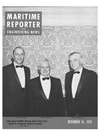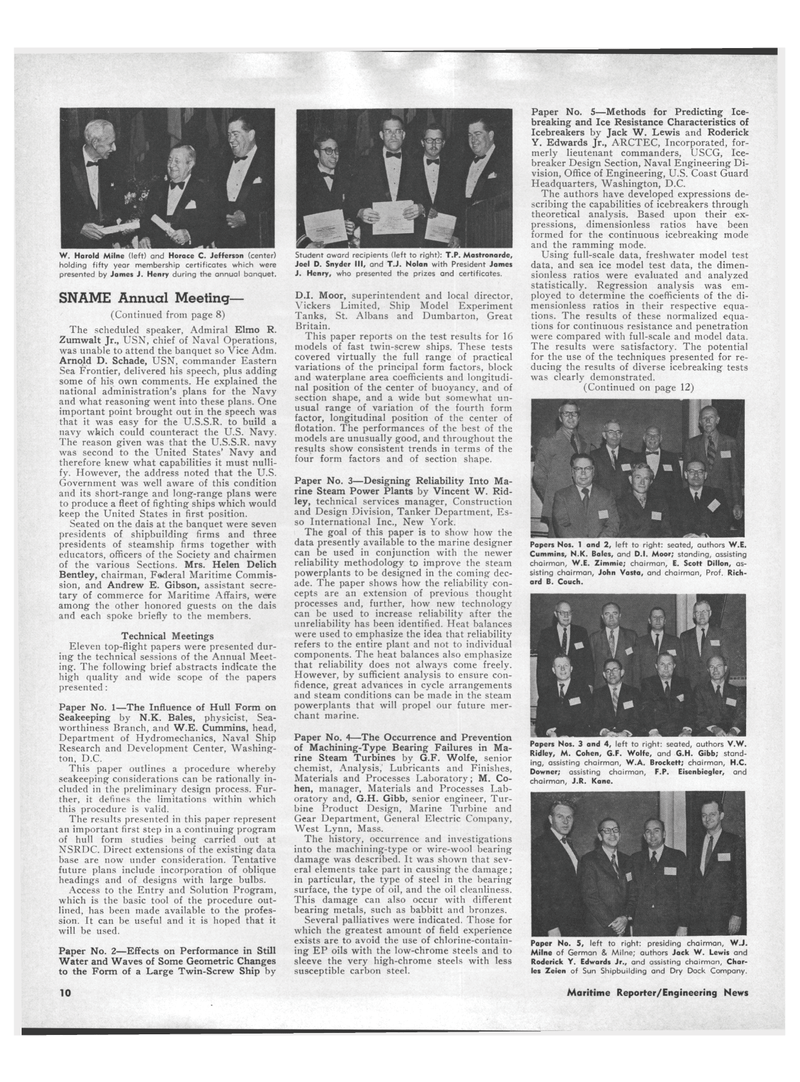
Page 8: of Maritime Reporter Magazine (December 15, 1970)
Read this page in Pdf, Flash or Html5 edition of December 15, 1970 Maritime Reporter Magazine
holding fifty year membership certificates which were presented by James J. Henry during the annual banquet.
SNAME Annual Meeting— (Continued from page 8)
The scheduled speaker, Admiral Elmo R.
Zumwalt Jr., USN, chief of Naval Operations, was unable to attend the banquet so Vice Adm.
Arnold D. Schade, USN, commander Eastern
Sea Frontier, delivered his speech, plus adding some of his own comments. He explained the national administration's plans for the Navy and what reasoning went into these plans. One important point brought out in the speech was that it was easy for the U.S.S.R. to build a navy which could counteract the U.S. Navy.
The reason given was that the U.S.S.R. navy was second to the United States' Navy and therefore knew what capabilities it must nulli- fy. However, the address noted that the U.S.
Government was well aware of this condition and its short-range and long-range plans were to produce a fleet of fighting ships which would keep the United States in first position.
Seated on the dais at the banquet were seven presidents of shipbuilding firms and three presidents of steamship firms together with educators, officers of the Society and chairmen of the various Sections. Mrs. Helen Delich
Bentley, chairman, Faderal Maritime Commis- sion, and Andrew E. Gibson, assistant secre- tary of commerce for Maritime Affairs, were among the other honored guests on the dais and each spoke briefly to the members.
Technical Meetings
Eleven top-flight papers were presented dur- ing the technical sessions of the Annual Meet- ing. The following brief abstracts indicate the high quality and wide scope of the papers presented:
Paper No. 1—The Influence of Hull Form on
Seakeeping by N.K. Bales, physicist, Sea- worthiness Branch, and W.E. Cummins, head,
Department of Hydromechanics, Naval Ship
Research and Development Center, Washing- ton. D.C.
This paper outlines a procedure whereby seakeeping considerations can be rationally in- cluded in the preliminary design process. Fur- ther, it defines the limitations within which this procedure is valid.
The results presented in this paper represent an important first step in a continuing program of hull form studies being carried out at
NSRDC. Direct extensions of the existing data base are now under consideration. Tentative future plans include incorporation of oblique headings and of designs with large bulbs.
Access to the Entry and Solution Program, which is the basic tool of the procedure out- lined, has been made available to the profes- sion. It can be useful and it is hoped that it will be used.
Paper No. 2—Effects on Performance in Still
Water and Waves of Some Geometric Changes to the Form of a Large Twin-Screw Ship by
Student award recipients (left to right): T.P. Mastronarde,
Joel D. Snyder III, and T.J. Nolan with President James
J. Henry, who presented the prizes and certificates.
D.I. Moor, superintendent and local director,
Vickers Limited, Ship Model Experiment
Tanks, St. Albans and Dumbarton, Great
Britain.
This paper reports on the test results for 16 models of fast twin-screw ships. These tests covered virtually the full range of practical variations of the principal form factors, block and waterplane area coefficients and longitudi- nal position of the center of buoyancy, and of section shape, and a wide but somewhat un- usual range of variation of the fourth form factor, longitudinal position of the center of flotation. The performances of the best of the models are unusually good, and throughout the results show consistent trends in terms of the four form factors and of section shape.
Paper No. 3—Designing Reliability Into Ma- rine Steam Power Plants by Vincent W. Rid- ley, technical services manager, Construction and Design Division, Tanker Department, Es- so International Inc., New York.
The goal of this paper is to show how the data presently available to the marine designer can be used in conjunction with the newer reliability methodology to improve the steam powerplants to be designed in the coming dec- ade. The paper shows how the reliability con- cepts are an extension of previous thought processes and, further, how new technology can be used to increase reliability after the unreliability has been identified. Heat balances were used to emphasize the idea that reliability refers to the entire plant and not to individual components. The heat balances also emphasize that reliability does not always come freely.
However, by sufficient analysis to ensure con- fidence, great advances in cycle arrangements and steam conditions can be made in the steam powerplants that will propel our future mer- chant marine.
Paper No. 4—The Occurrence and Prevention of Machining-Type Bearing Failures in Ma- rine Steam Turbines by G.F. Wolfe, senior chemist, Analysis, Lubricants and Finishes,
Materials and Processes Laboratory; M. Co- hen, manager, Materials and Processes Lab- oratory and, G.H. Gibb, senior engineer, Tur- bine Product Design, Marine Turbine and
Gear Department, General Electric Company,
West Lynn, Mass.
The history, occurrence and investigations into the machining-type or wire-wool bearing damage was described. It was shown that sev- eral elements take part in causing the damage; in particular, the type of steel in the bearing surface, the type of oil, and the oil cleanliness.
This damage can also occur with different bearing metals, such as babbitt and bronzes.
Several palliatives were indicated. Those for which the greatest amount of field experience exists are to avoid the use of chlorine-contain- ing EP oils with the low-chrome steels and to sleeve the very high-chrome steels with less susceptible carbon steel.
Paper No. 5—Methods for Predicting Ice- breaking and Ice Resistance Characteristics of
Icebreakers by Jack W. Lewis and Roderick
Y. Edwards Jr., ARCTEC, Incorporated, for- merly lieutenant commanders, USCG, Ice- breaker Design Section, Naval Engineering Di- vision, Office of Engineering, U.S. Coast Guard
Headquarters, Washington, D.C.
The authors have developed expressions de- scribing the capabilities of icebreakers through theoretical analysis. Based upon their ex- pressions, dimensionless ratios have been formed for the continuous icebreaking mode and the ramming mode.
Using full-scale data, freshwater model test data, and sea ice model test data, the dimen- sionless ratios were evaluated and analyzed statistically. Regression analysis was em- ployed to determine the coefficients of the di- mensionless ratios in their respective equa- tions. The results of these normalized equa- tions for continuous resistance and penetration were compared with full-scale and model data.
The results were satisfactory. The potential for the use of the techniques presented for re- ducing the results of diverse icebreaking tests was clearly demonstrated. (Continued on page 12)
Papers Nos. 1 and 2, left to right: seated, authors W.E.
Cummins, N.K. Bales, and D.I. Moor; standing, assisting chairman, W.E. Zimmie; chairman, E. Scott Dillon, as- sisting chairman, John Vasta, and chairman, Prof. Rich- ard B. Couch.
Papers Nos. 3 and 4, left to right: seated, authors V.W.
Ridley, M. Cohen, G.F. Wolfe, and G.H. Gibb; stand- ing, assisting chairman, W.A. Brockett; chairman, H.C.
Downer; assisting chairman, F.P. Eisenbiegler, and chairman, J.R. Kane.
Paper No. 5, left to right: presiding chairman, WJ.
Milne of German & Milne; authors Jack W. Lewis and
Roderick Y. Edwards Jr., and assisting chairman, Char- les Zeien of Sun Shipbuilding and Dry Dock Company. 10 Maritime Reporter/Engineering News

 7
7

 9
9
